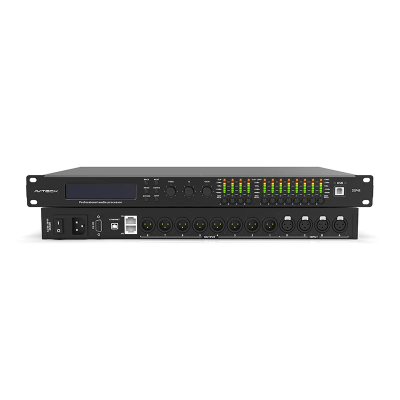
- English
- Español
- Português
- русский
- Français
- 日本語
- Deutsch
- tiếng Việt
- Italiano
- Nederlands
- ภาษาไทย
- Polski
- 한국어
- Svenska
- magyar
- Malay
- বাংলা ভাষার
- Dansk
- Suomi
- हिन्दी
- 繁体中文
- العربية
- Indonesia
- فارسی
- Eesti Keel
- Srpski језик
- Afrikaans
- icelandic
- беларускі
- Hrvatski
- ភាសាខ្មែរ
- ქართული
- Maori
- Тоҷикӣ
- O'zbek
- Հայերեն
- Lietuvos
- שפה עברית
- Pilipino
- Türkçe
- Gaeilge
- Norsk
- český
- ελληνικά
- український
- български
- ລາວ
- Latine
- Қазақша
- Slovenský jazyk
What are the differences between an audio processor and a power amplifier?
2025-09-11
Differences in function and effect:
The audio processor is mainly used for processing, adjusting, and effecting audio signals. It can achieve various audio processing effects such as equalization, filtering, reverb, compression, delay, etc., to improve the audio quality, balance the sound, and add special effects. While the power amplifier is used to amplify audio signals, converting the low-level audio signals into a sufficient level to drive the speakers, so as to produce audible sounds. At the same time, the audio processor allows users to make fine adjustments to the audio signals as needed to meet different audio system requirements. Through the audio processor, one can adjust the balance of high and low frequencies, volume, spatial perception, and color characteristics of the sound. The power amplifier is responsible for enhancing the processed audio signals so that they are powerful enough to drive the speakers and produce high-quality sound output.

Depending on the connection method and device type:
The audio processor usually connects to other audio devices through input and output interfaces to receive and process audio signals, and then outputs the processed signals to the power amplifier or audio system. The power amplifier is generally directly connected to the output end of the audio processor to receive the processed audio signals and amplify them before outputting them to the speakers. Moreover, the audio processor is usually an independent device that can be purchased and configured separately. They offer a wide range of audio processing functions and usually have a user-friendly control interface. The power amplifier can be used as an independent device or integrated into other audio equipment.
| User Control | Allows frequency volume spatial adjustments | No audio modification | |
| Signal Handling | Receives processes outputs to amplifier | Receives processed signals drives speakers | |
| Device Format | Standalone unit with interfaces | Standalone or integrated |
In practical real-life applications, audio processors are mainly used to process and adjust audio signals in order to improve sound quality and add special effects, while amplifiers are used to amplify the processed audio signals and drive speakers. These two components play different roles in the audio system and work together to achieve high-quality audio output.



